Costs & Pricing of Professional Laser Hair Removal
The safe and long-lasting results of laser hair removal have made it the primary choice for eliminating unwanted body hair.
It doesn’t damage the surrounding tissue and is done with minimal pain and recovery time.
However, you should always make an informed choice by comparing the cost and benefits of professional vs. at-home laser hair removal vs. other methods like waxing or shaving.
The study below details the cost of professional laser hair removal done by physicians and estheticians throughout the Unites States.
It also covers the varying factors that affect prices as well as an essential overview of what you should know as a patient.
By the end of this report, you should have a good grasp of what professional laser hair removal entails and be well-informed before making your first appointment.
- Costs & Pricing of Professional Laser Hair Removal
- Laser Hair Removal Cost Statistics Report: Results
- Ask the Expert: How many treatments do you need to achieve long-term results?
- Methodology
- Initial Consultation
- Cost & Pricing Factors
- Insurance Coverage
- Laser Hair Removal Technology
- Frequently Asked Questions:
- References:
Laser Hair Removal Cost Statistics Report: Results
The cost of professional laser hair removal is mainly determined by your geographic location, the size of the treated area, specific patient needs, and the quality of practice.
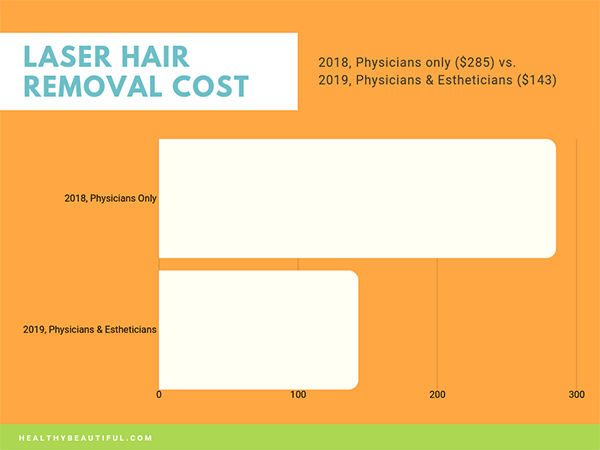
Laser hair removal is not a one-off process. Results require multiple treatments spaced 3-6 weeks apart due to hair cycle phases. How many you will ultimately need depends on your genetics, race, and individual factors (eg. hormones). It also relies on the body area and the device used.
According to the 2018 Plastic Surgery Statistics Report, the national average surgeon or physician fee for laser hair removal is $285. Assuming you go in for the minimum required six sessions, it adds up to $1,710. These fees generally do not include anesthesia, operating room facilities or other related expenses.
The 2019 Laser Hair Removal Cost Statistics Report, which includes the average fees of IPL services performed by laser technicians in medical spas and clinics, marks it down to $143 per treatment. If you go for a minimum of six treatments, it would total $858.
As it is considered a cosmetic procedure, most health insurance plans do not cover cosmetic surgery or its complications.
Full Body Diagram of Laser Hair Removal Treatment Areas
Common body areas are covered by laser skin clinics. You can use this as a general guide for the treatment’s extent of coverage.
The treatment size and body area location are another major determining factor of prices. Larger areas with thicker hair tend to be more expensive.
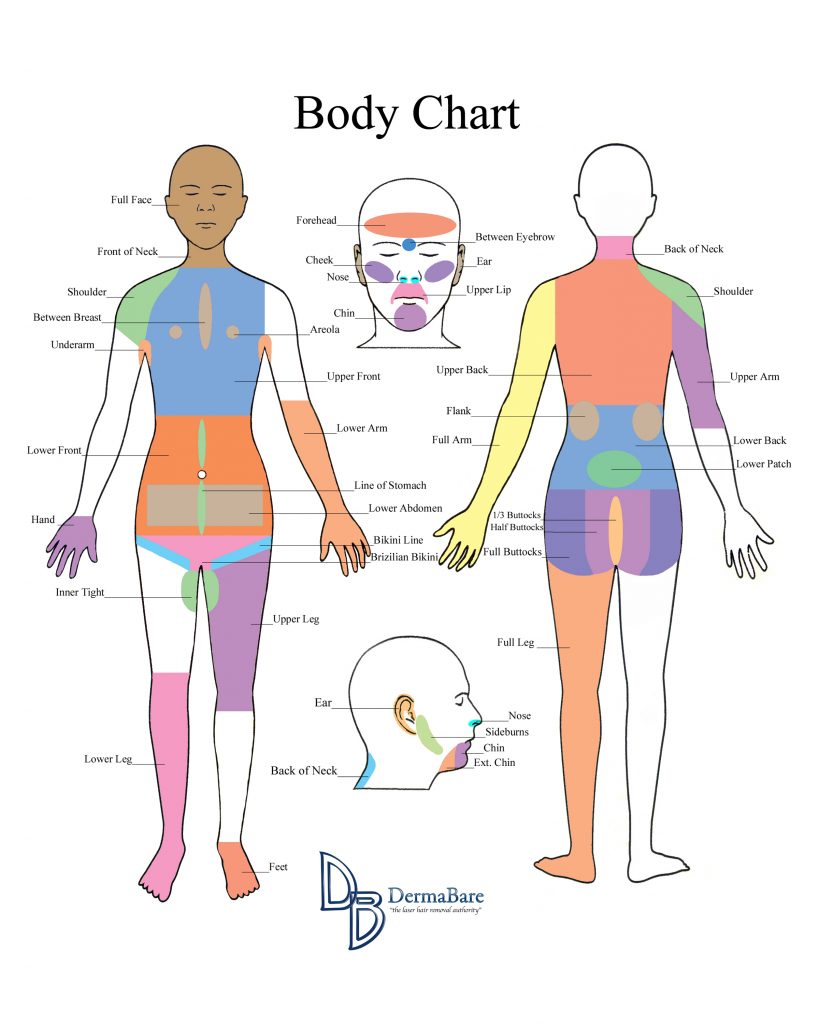
The Average Professional Laser Hair Removal Prices In the US Per Treatment Area
This is priced on a per session basis. Depending on your current skin and hair condition, full treatments may range from 6-8 sessions, at 3-6 weeks interval. These may come as a package or can be bought as separate treatments.
Male prices are 25%-30% higher on average because of coarser and more concentrated hairs that take more treatment time and laser energy.
There are many variables that can affect your treatment, but most people would need 6-8 sessions for full results. For more accurate pricing, contact your local provider.
| Laser Treatment Area | Treatment Area Description | Female Price | Male Price | Unisex Price | Laser Area Size | Body Region |
|---|---|---|---|---|---|---|
| Face, Full | Usually customized per client and can include any of these areas: forehead, above and between the eyebrows, cheeks, sideburns, nose, upper lip, chin, jawline | $188 | $297 | $274 | Medium | Face |
| Eyebrows | Usually used in contouring or shaping the eyebrows | $83 | $79 | $83 | Small | Face |
| Glabella (Unibrow) | Between the eyebrows, for correcting unibrows | $63 | $63 | $62 | Small | Face |
| Cheeks | From dark, coarse hair to light peach fuzz on the cheeks, usually gets in the way of makeup application | $93 | $97 | $95 | Small | Face |
| Sideburns | Lateral cheeks, close to the ears and hairline | $90 | $87 | $91 | Small | Face |
| Ears | Usually done on men who develops excess hair on their outer ear in their 20s to late 30s | $72 | $70 | $70 | Small | Face |
| Nose | Targets visible nose hairs around the nostrils | $62 | $59 | $57 | Small | Face |
| Upper Lip | From mustaches to peach fuzz above the lips | $74 | $75 | $75 | Small | Face |
| Chin | Hair below the lower lips | $83 | $84 | $84 | Small | Face |
| Beard/Jaw | Area from the chin extending to the ear and upper neck | $145 | $158 | $154 | Medium | Face |
| Neck, Front | From under the jawline to the above collarbone, prices can vary with the amount of surface area to be treated | $112 | $113 | $113 | Medium | Neck |
| Neck, Back/Nape | Base of the neck at the back | $104 | $105 | $106 | Medium | Neck |
| Shoulders | Usually from the collarbone or clavicle on the front to the shoulder joint | $162 | $166 | $168 | Medium | Upper torso |
| Underarms/Axilla | The junction of the upper limb and thorax | $116 | $116 | $117 | Medium | Upper limbs |
| Arms, Full | Usually from the wrist to the shoulder | $255 | $261 | $261 | Large | Upper limbs |
| Arms, Upper | From above the elbow to the shoulder | $172 | $179 | $172 | Medium | Upper limbs |
| Arms, Lower/Forearms | Usually from the wrist to 2 inches above the elbow | $164 | $169 | $167 | Medium | Upper limbs |
| Hands | Dorsal surface to start of wrist flexure | $85 | $87 | $86 | Small | Upper limbs |
| Fingers | Usually on the knuckles | $47 | $46 | $44 | Small | Upper limbs |
| Chest | Usually from the collarbone or clavicle to the bottom of the sternum | $227 | $240 | $233 | Large | Upper torso |
| Sternum | Breastbone or the area between each chest | $76 | $79 | $76 | Small | Upper torso |
| Breast | If hair extends outside the nipple area | $114 | $114 | $114 | Medium | Upper torso |
| Pero-Areola | Nipple area, including both sides | $74 | $76 | $75 | Small | Upper torso |
| Abdomen | From the bottom of the sternum or ribcage to the standard waistline | $189 | $203 | $198 | Large | Upper torso |
| Navel | Hair around and within the belly button | $83 | $84 | $87 | Small | Upper torso |
| Linea Nigra Line/Happy trail | The line from the upper pubic hair to the navel, up to 3×6 inches | $85 | $93 | $89 | Small | Upper torso |
| Back, Full | Shoulder to shoulder, down to the line above the buttocks | $329 | $344 | $337 | Extra large | Torso |
| Back, Upper | Shoulder to waist | $200 | $214 | $211 | Large | Upper torso |
| Back, Lower | From the waist to the line above the buttocks | $173 | $188 | $182 | Medium | Upper torso |
| Brazilian | Includes nearly all the hair from front to back | $205 | $218 | $215 | Large | Upper torso |
| Bikini, Full/Extended | Lateral groin areas plus upper pubic hair reduction | $169 | $183 | $179 | Medium | Upper torso |
| Bikini, Basic | Lateral groin areas only, 2 inches max into the thigh area and (for the female) up to the labia | $131 | $136 | $135 | Medium | Upper torso |
| Buttocks | Includes butt cheeks | $195 | $197 | $197 | Medium | Upper torso |
| Bikini, Anal | Perianal area located around the rectum and the perineum (bit of skin between the rectum and genitals) | $88 | $99 | $103 | Medium | Upper torso |
| Legs, Full | Below the lateral groin to the ankles | $391 | $378 | $394 | Extra large | Lower limbs |
| Legs, Upper/Thighs | Between the hip (pelvis) and the knee | $247 | $248 | $248 | Large | Lower limbs |
| Sacrum | From the top of the gluteal cleft (groove between the buttocks) up to 4 inches vertical and 3 inches horizontal | $98 | $106 | $99 | Small | Upper torso |
| Legs, Lower | Between the knee and the ankle | $234 | $231 | $235 | Large | Lower limbs |
| Feet | Ventral surface to the top of the tarsal bones | $85 | $83 | $85 | Small | Lower limbs |
| Toes | On the tops of your feet and toes | $52 | $54 | $51 | Small | Lower limbs |
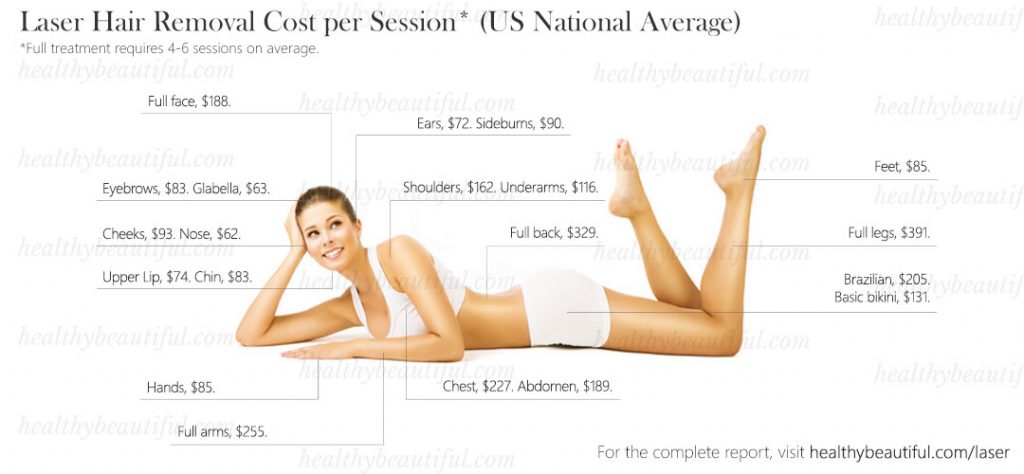
Overview Of the US National Average Fees For Laser Hair Removal

The Average Professional Laser Hair Removal Prices in the US Per State, Per Treatment Area
This includes aggregate fees of plastic surgeons and laser technicians in medical spas. N/A is where not enough data is collected.
Again, these are on a per session basis. Most people would need 5-10 sessions to get full results.
Click the (+) to expand. For easier viewing, you can use the search box on the upper right of the table and type in your state.
| wdt_ID | US State | Face, Full | Glabella | Cheeks | Sideburns | Ears | Upper Lip | Chin | Beard/Jaw | Neck, Front | Neck, Back | Shoulders | Underarms | Arms, Full | Arms, Upper | Arms, Lower | Hands | Chest | Pero-Areola | Abdomen | Linea Nigra Line/Happy trail | Back, Full | Back, Upper | Back, Lower | Brazilian | Bikini, Full | Bikini, Basic | Buttocks | Legs, Full | Legs, Upper/Thighs | Legs, Lower | Feet |
|---|---|---|---|---|---|---|---|---|---|---|---|---|---|---|---|---|---|---|---|---|---|---|---|---|---|---|---|---|---|---|---|---|
| 1 | Alabama | $150.00 | $48.67 | $109.67 | $68.00 | $59.67 | $49.00 | $59.67 | $152.00 | $151.00 | $138.50 | $275.00 | $143.00 | $393.00 | $209.67 | $219.75 | $63.50 | $214.50 | $68.00 | $244.75 | $75.00 | $389.50 | $229.00 | N/A | N/A | $152.00 | $89.50 | $266.67 | $439.50 | $344.75 | $319.75 | $69.75 |
| 2 | Alaska | $269.00 | $67.00 | N/A | $88.00 | $63.00 | $76.83 | $83.50 | $163.00 | $137.50 | N/A | $267.00 | $158.33 | $283.50 | $200.00 | $200.00 | $100.00 | $333.33 | $88.00 | $225.00 | $83.50 | $455.67 | $250.00 | $250.00 | $355.67 | $150.00 | $250.00 | $150.00 | $522.33 | $355.67 | $355.67 | N/A |
| 3 | Arizona | $98.60 | $29.33 | $65.00 | $50.00 | $27.67 | $39.67 | $49.67 | $139.50 | $68.00 | $52.25 | $79.67 | $65.75 | $133.33 | $87.00 | $82.25 | $43.33 | $134.50 | $40.00 | $119.50 | $34.50 | $183.00 | $112.50 | $112.50 | $137.00 | $112.50 | $63.00 | $119.50 | $250.00 | $154.75 | $121.00 | $37.25 |
| 4 | Arkansas | $165.00 | N/A | N/A | $93.75 | $93.75 | $78.13 | $101.25 | $200.00 | $135.42 | $125.00 | $163.75 | $132.50 | N/A | $168.75 | $168.75 | $112.50 | $270.83 | $110.00 | $200.00 | $62.50 | $418.75 | $231.25 | $200.00 | $195.17 | $188.00 | $116.67 | N/A | $358.33 | $200.00 | $200.00 | $125.00 |
| 5 | California | $198.33 | $52.50 | $91.33 | $91.33 | $48.33 | $78.33 | $86.67 | $195.00 | $107.33 | $111.00 | $117.50 | $116.33 | $250.25 | $165.00 | $143.33 | $91.67 | $178.33 | $64.33 | $146.67 | $118.00 | $344.00 | $397.00 | $240.00 | $181.67 | $179.33 | $120.67 | $161.67 | $376.33 | $257.00 | $226.00 | $85.00 |
| 6 | Colorado | $167.00 | $67.50 | $43.33 | $79.00 | N/A | $65.75 | $61.33 | $150.00 | $122.67 | $116.00 | $152.67 | $78.60 | $184.60 | $136.00 | $136.00 | $79.00 | $230.75 | $75.00 | $197.00 | $79.00 | $280.75 | $136.00 | $137.00 | $174.60 | $133.33 | $79.67 | $133.60 | $246.60 | $172.00 | $170.60 | $78.25 |
| 7 | Connecticut | $444.28 | $79.50 | $100.00 | $219.56 | $133.75 | $161.37 | $204.33 | $266.11 | $230.67 | $200.67 | $298.67 | $278.29 | $470.44 | N/A | $333.17 | $152.00 | $418.44 | $98.50 | $426.83 | N/A | $639.27 | $425.00 | $425.00 | $500.00 | $240.17 | $262.72 | $437.50 | $792.25 | $477.83 | $441.92 | $188.50 |
| 8 | Florida | $201.33 | $70.00 | $162.50 | $112.50 | $72.50 | $78.33 | $78.33 | $131.67 | $102.00 | $94.67 | $213.00 | $123.00 | $232.50 | $179.67 | $174.75 | $75.83 | $219.50 | $97.50 | $149.50 | $86.67 | $295.00 | $182.00 | $174.67 | $174.67 | $180.00 | $134.67 | $196.00 | $371.67 | $209.67 | $209.67 | $75.83 |
| 9 | Georgia | $135.91 | $70.83 | N/A | $62.50 | $78.13 | $51.88 | $92.50 | $152.50 | $92.25 | $132.81 | N/A | $88.75 | $212.81 | $950.00 | $118.75 | $62.50 | $150.23 | $108.63 | $143.48 | $179.17 | $264.96 | $80.00 | $80.00 | $177.50 | N/A | $101.23 | $157.25 | $287.75 | $229.13 | $196.84 | $70.31 |
| 10 | Hawaii | $198.11 | N/A | $97.83 | $85.33 | $79.17 | $85.33 | $87.33 | $223.11 | $104.08 | $104.08 | $229.00 | $110.33 | $337.75 | $231.83 | $238.08 | $91.58 | $231.83 | $79.00 | $218.58 | $94.33 | $345.00 | $209.11 | $183.11 | $213.78 | $191.67 | $141.67 | $229.00 | $379.33 | $296.08 | $283.58 | $91.58 |

Ask the Expert: How many treatments do you need to achieve long-term results?
by SAMANTHA WELCH, ESTHETICIAN
A series of 8+ treatments is required for effective long-term results.
Some people see results that last for years after just one series while others require multiple series of treatments over time to maintain hair loss.
Due to varying factors such as the type of laser used, laser parameters used, anatomical site or treatment area, and individual hair biology; it’s not possible to determine in advance with 100% accuracy exactly how many treatments you will need or how long results will last.
Methodology
Sample, Questionnaire and Interviewing.
The universe for this study is the service fees for laser hair removal in the continental US. This does not include anesthesia, operating room facilities, and other related expenses. The sample was selected in two stages. In the first stage, the sampling frame was a list of medical and aesthetic practices that offered laser hair removal as part of their service. The second stage of sampling was on data viability. In practices where sufficient data collection was reached, the data then was deconstructed to fall in line with our categorical sets.
The survey consists of 1,020 interviews. All sample surveys are subject to possible sampling error; that is, the results may differ from those which obtained if the entire population under study were interviewed. The margin of sampling error for the entire survey is plus or minus 2.5 percentage points at the 95 percent level of confidence. This means that in 95 out of 100 samples of this size, the results obtained in the sample would fall in a range of plus or minus 2.5 percentage points of what would have been obtained if every practice in the U.S. had been interviewed.
Initial Consultation
Your initial consultation with will usually involve: setting your goals and expectations for the treatment, discussing your medical condition and history, your current medications, an explanation of the various aspects of laser hair removal, a physical evaluation including a skin and hair assessment, any risks or potential complications, and a recommendation of a course of treatment.
When choosing a provider, consider the following:
- Quality of the practice – This can range from board-certified dermatologists to laser technicians in clinics. Always ask for before and after photos from their other patients. (They should be showing these off.)
- Pricing – Is it within your budget? (Compute by your estimated total no. of sessions. Packaged pricing comes with a discount but are paid up front.) Is it covered by your insurance? (Cosmetic procedures are unlikely, but some plastic surgeons have financing plans.)
- Convenient location – you’ll need multiple visits to complete your treatment
- Equipment and technology used, especially for Fitzpatrick skin types (FST) IV-VI, as they usually require certain types of machines[1]
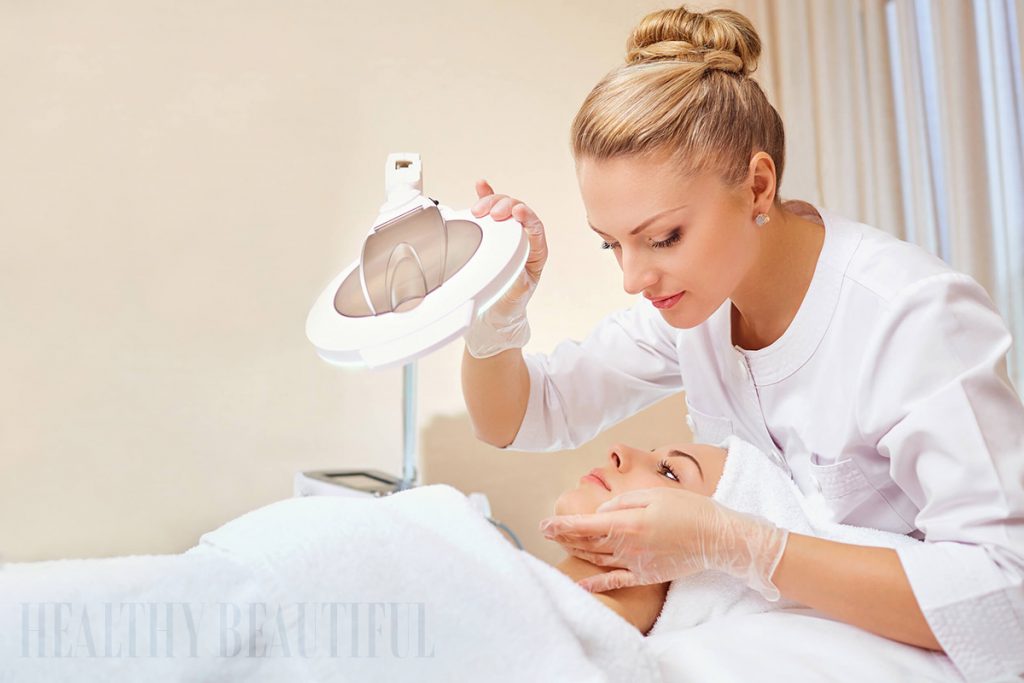
Here are some guide questions you can ask your laser provider:
- What are my options for hair removal, and which procedure is the best one for me?
- Can you walk me through the process of the treatment?
- What is the estimated cost of the procedure per session and overall? Do you have packages and do those come with a discount? Is it covered by my insurance? (Unlikely, but no harm in asking!)
- How long is one appointment?
- How often and how far apart are should my treatments be?
- What are the risks, common side effects or complications of this procedure?
- How can I prepare for the treatment? Do you have a list I can refer to as a reminder?
- Does the treatment hurt? What are my pain management or anesthesia options and how much do they cost?
- What should I expect after the procedure? (e.g. recovery time, short-term and long-term effects, activity restrictions, etc.)
- Do you have before-and-after photos from your previous patients to help me prepare for what to expect?
Cost & Pricing Factors
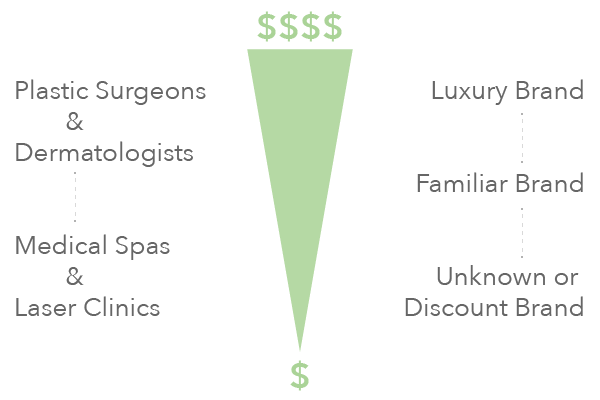
The cost of laser hair removal can vary according to the business locality, standards of practice, extent of areas to be treated, current skin and hair condition, as well as the frequency of visits.
- Practice Location – The cost of living varies per state and impacts goods and services, including aesthetic procedures like laser hair removal. Prime locations tend to be more expensive as they also bear higher overheads and real estate expenses.
- Local Market – Larger markets and those with a greater cultural emphasis on aesthetics tend to have more competition. For example, California is far more competitive than Ohio.
- Expertise & Quality of Practice – Some practices may be equipped with more advanced laser removal technology and may offer personalized services to their patients. Ideally, the best choice are qualified cosmetic surgeons because they follow the same medical standards for non-invasive laser hair removal as they do medical procedures. They are usually in dermatology and plastic surgery practices and charge more than laser clinics and medical spas.
- Luxury brands also tend to charge more for the same service as a regular medical spa. The most expensive laser hair removal provider will be an in-house physician for a luxury brand.
Pricing Structure
Pricing can vary but these are the industry standard for professional laser hair removal. These can be tailored to your needs after an assessment.
- Body Treatment Area – You are usually charged a flat fee according to body areas. The price increases with the area and thickness of hair.
- Size Categories – Another common pricing method is grouping treatment areas according to their general size.
- Small (approx. $75) – Areola, Brows, Cheeks, Chin, Ears, Feet, Hands, Happy Trail, Knuckles, Nose, Sideburns, Toes, Upper Lip
- Medium (approx. $125) – Back Neck, Bikini Line, Breasts, Buttocks, Front Neck, Full Face, Lower Arms, Lower Back, Shoulders, Underarms, Upper Arms
- Large (approx. $175) – Abdomen, Brazilian, Chest, Full Arms, Lower Back, Lower Legs, Upper Back, Upper Legs
- Extra Large (approx. $300) – Full Back, Full Torso, Full Legs
- Full body (approx. $1200)
- Packages – Because laser hair removal needs multiple treatments to be effective, clinics tend to offer treatment packages at a discount and to make you pay in full, up front. These start at 6 treatments up to 10. Custom packages can also be offered that bundles specific areas one treatment. Eg. Women’s Swim Package (approx. $2000) – Bikini, Underarms, Full legs x 6 treatments.
Insurance Coverage
According to the American Society of Plastic Surgeons, laser hair removal is the #4 cosmetic minimally invasive procedure done in 2018 with over 1 million done in the United States.[2]
Laser hair removal is considered cosmetic surgery, so is not usually covered by insurance. If you have a medical condition such as hirsutism, a hormonal disorder, you can contest this to your insurance as a medical necessity.
Some plastic surgeons have patient financing plans, you can ask during your consultation. (Personally, I wouldn’t go into debt for this as there are medi-spas and at-home devices can be effective and affordable solutions.)
Laser Hair Removal Technology
Understanding laser and light systems is important because you want to know which type of laser technology is the most compatible for your skin tone and hair color. While most of them technically CAN remove any type of hair on almost anyone, there are pros and cons to each of them. As a consumer, it’s wiser to invest time and money in a clinic that uses a machine that works best for you so you can maximize each session.
The key principle is matching the wavelength of light and pulse duration to a single target—the melanin in your hair follicle. (Melanin is what gives our skin and hair it’s color.) As the melanin heats up, it destroys the root and disables the blood flow to the follicle. This disables the hair growth permanently. The process has to be fast and precise so the hair bulb is destroyed without damaging the surrounding tissue.
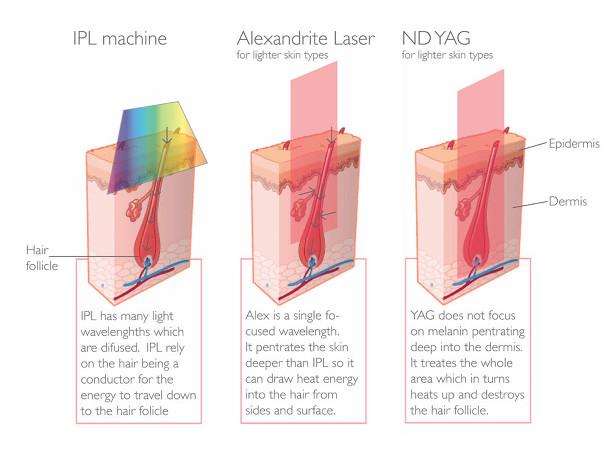
Not all laser hair removal systems are compatible with every combination of skin and hair types. As an example, shorter wavelength machines such as Alexandrite and Ruby can deliver more energy to finer hairs but is also absorbed by the skin’s melanin, heightening the risk for burns or blisters. Longer wavelengths like Diodes and Nd:YAG are much more effective for permanent hair reduction of coarser hairs but are also reported to be more painful. This type of lasers require cooling systems to make the treatment comfortable.
Alexandrite and diode lasers are recommended for women with hirsutism. Less evidence is available for short-term effects of pulsed light, Nd:YAG, and ruby lasers.[3]
As machines continue to evolve with the popularity of hair removal, some devices have dual technologies. Eg. The Duetto have both Alexandrite and Nd:YAG lasers.
The most common technology used for hair removal are:
| Technology | Wavelength (nm) | Repetition rate | Spot size | Laser/Light Source | Skin Type Coverage | Pulse width |
|---|---|---|---|---|---|---|
| Ruby Laser | 694 nm | 0.5 – 1.2 hz | 3-10 mm | Red light | Light skin (Fitzpatrick I-II) with dark hair | 0.85-3 ms |
| Alexandrite Laser | 755 nm | 5 Hz | 6-16mm | Infrared | Light to olive complexions (Fitzpatrick I-IV) | 5-140 ms |
| neodymium-doped yttrium aluminum garnet (Nd:YAG) | 1064 nm | up to 10 Hz | 3-5 mm | Infrared | Olive to dark complexions (Fitzpatrick I-VI) | 10-50 ms |
| Intense Pulsed Light (IPL) | 590 – 1200 nm | 2 to 3 cm2 | Broad spectrum light (ie. not an actual laser) | Light to olive complexions (Fitzpatrick I-IV) |
Legend:
- Wavelength – depth of penetration, must be within the absorption spectrum of melanin
- Spot size – width of the laser beam
- Repetitions – rapid reps mean faster treatments, and less trauma on the surrounding skin
- Skin Type Coverage – Based on The Fitzpatrick Scale
Ruby Laser
The oldest type (antiquated really, but we’ve included it just so we’ve covered everything) in this list, and works best for fine, light hair and light skin (Fitzpatrick I-II). It can be effective on dark colored skin but comes with a higher risk of side effects like hypopigmentation.[4]
It also covers a smaller treatment area compared to other lasers and has a slower repetition rate. This makes the overall treatment more time consuming but on the up side makes it less painful.
Its main advantage used to be a built-in cooling system that minimizes the typical risks like the intense heat, burning, swelling, and discoloration. Cooling systems are now found with the latest models of the rest of the lasers and can be bought separately nowadays, so this should not be much of an advantage over the others.
Ideal for: Light skin (Fitzpatrick I-II), Fine and light hair, Small areas only
Cons: Higher risk for side-effects, low efficacy for dark skin
Ruby Lasers we like: None, tbh we haven’t used one but some machines are Palomar E2000, RubyStar, and EpiPulse Ruby.
Alexandrite Laser
The one of the fastest lasers with its high repetition rate and large spot size, making it suitable for wide areas like the back and legs. The machine is also a fraction of the size of a Ruby, which makes it more convenient to work with.
The Alexandrite has a relatively short wavelength compared to the other lasers, which comes with its pros and cons. The laser energy that is effectively absorbed by the melanin in the hair is also absorbed by the melanin in the epidermis. This means, those with a lot of melanin or have darker skin tones are susceptible to post-inflammatory hypopigmentation. (These are temporary in nature though, but can still delay the treatment further down for this skin type.) On the up side, this makes a version of the Alexandrite, the Q-switches, very effective on tattoos and lentigines.
Alexandrite lasers are also more effective on finer, thinner hairs compared to diode, and can even treat patients with freckles.
Found to be less painful than Nd:YAG.
Ideal for: Light to olive complexions (Fitzpatrick I-IV), Fine and thin hairs, Large treatment areas like the back, legs, and arms
Cons: Can cause discoloration on darker skin tones.
Popular 755 Alexandrite Machines: Candela GENTLEMAX PRO® (755nm & 1064nm), Candela GENTLEYAG PRO® (1064nm only), Cutera Excel® HR (755nm & 1064nm), Motus AX & AY, Cynosure Apogee, GentleLase, EpiTouch Plus
Pulsed Diode Array
Studies have shown this to be better than Alexandrite for dark skin types because of its ability to penetrate deeper into the dermis layer.[5] It also decreases risk of epidermal damage because of its longer wavelength, which can also be customized depending on the patient’s need. This also means that integrated cooling is needed to ease patient discomfort.
Rapid repetitions mean faster treatments, and less trauma on the surrounding area means a faster recovery period.
Diode is more effective on coarse hair that other systems, making it ideal for men and on areas with coarse hair.
In a 2006 study of the efficacy of IPL vs. Alexandrite and diode laser, all three have shown similar results, with the diode edging a little on hair reduction but with more side effects.[6]
There is a portable version of this technology, in the Tria 4x and ViQure EpiPro.
Ideal for: Light to olive complexions (Fitzpatrick I-IV), Coarse hair
Popular Diode Machines: LightSheer Diode, Cynosure, F1 Diode, MeDioStar, SopranoXL, SLP, LaserLite, EpiStar, Apex
neodymium-doped yttrium aluminum garnet (Nd:YAG)
What makes Nd:YAG unique is its optimal balance for light absorption. The melanin and haemoglobin absorbs very little light, which allows it to penetrate deeply without thermally affecting the surrounding tissue. Its low scattering coefficient guarantees that the laser penetrates to the deepest follicles. As it has the longest wavelength, fewer pulses are also needed.
Since melanin scarcely absorbs the Nd:YAG, darker skin types can be safely treated and is more effective on dark skin. This also means however, treatment is less effective compared to ruby or Alexandrite and on light or fine hair.[7]
Ideal for: Olive to dark complexions (Fitzpatrick IV-VI), Darker skin tones—Asians, Hispanic and Latinos, African American, Pacific Islanders + Tanned Caucasian skin
Cons: Not as effective for removing fine hair
Popular Nd:YAG Machines: Candela GENTLEMAX PRO® (755nm & 1064nm), Candela GENTLEYAG PRO® (1064nm only), Cutera Excel® HR (755nm & 1064nm), Cutera Xeo, Cynosure, GentleYAG, Medlite IV, Sciton, Cutera
Intense Pulsed Light (IPL)
IPL technically doesn’t use laser (ie. one beam of light) but broad-spectrum light. So even though its one of the most popular technology used both in clinics and at-home laser hair removal devices, it’s not a “true” laser. However, it still gets the job done and on a much more affordable scale so it’s here to stay. (And tbh, hardware doesn’t really matter as long it works for you!)
IPL machines are highly customizable to various skin tone, hair type, and treatment area, making it available to a wider range of clients. Newer tech has made it available to a lot of portable devices, making it the predominant technology in at home laser hair removal.
One study have shown IPL has less side effects and higher satisfaction scores compared to Nd:YAG, although all the previous lasers are shown to be more effective in permanent hair removal on certain cases.[8]
Most procedures are effective on the combination of dark hair on light skin. The latest technologies have now made it safer for patients with lighter hair and dark skin.
Ideal for: Affordable laser hair removal solutions
Cons: Would require more regular and long-term treatments for hair reduction
Popular IPL Machines: Aculight, Quantum, Vasculight, Epilight, PhotoDerm
Frequently Asked Questions:
Yes, there is a permanent reduction but it’s not a one-off series of treatments. Some people will have to go back for another series at some point to keep it at bay.
Those that need follow-up treatments usually have hair growth that is hormone-driven. 10-20% of females have PCOS (Polycystic Ovarian Syndrome), which is very common. This can cause hirsutism, which excessive hair growth. If you have it (like I do), laser hair removal doesn’t work as well when it comes to permanency. You might need to return 2-3 times on the first year, and annually thereafter. (Quick medical tip if you have PCOS: You can include a TVCS or transvaginal ultrasound on one of your OB visits to just to make sure that those cysts are kept in check. If you’re predisposed, it’s better to be safe than sorry.)
For men, who have a lot of testosterone, hair tends to be thicker (especially on the back). They will need more treatments, sometimes up to 10. And because its testosterone-driven, sometimes it returns much quicker than normal.
– Shave the area prior to treatment. Some medispas also offer this as a service for an extra charge.
– Do not apply or remove any lotions, creams, perfumes, deodorants, or any potential irritants in the treatment area
– Avoid aspirin, anti-inflammatory drugs, and herbal supplements to decrease the risk of bleeding
For 2-3 weeks prior to your first treatment and throughout, avoid:
– Plucking & Waxing – the hair root is needed for deactivation
-Tanning & Excessive Sun Exposure – this can interfere with the absorption of light and cause unusual lightening of the skin
-Artificial tanning lotions – can also interfere with light absorption and cause unusual bumps and burns
-Chemical peels
-Collagen Injections
-Depilatory Creams
-Medications that make you sensitive to light – this makes the skin more susceptible to burning and scarring
A handheld device flashes concentrated light to the skin. If needed, a cooling air, gel, or spray is applied. You may feel a stinging or tingling sensation, but this is usually minimal.
Duration of the treatment can span anywhere from 10 minutes to an hour, depending on the area.
There may be a mild sensation similar to a sunburn and possibly some minor swelling of the hair follicle. This is a normal occurrence and usually lasts for about 2-24 hours after treatment. If it becomes a bother, the area can be soothed by applying cooling gel or over-the-counter pain meds. You may also be given topical antiseptic cream after treatment.
Avoid direct sun exposure for at least a week after the laser procedure.
7-30 days after, the treated hair will slowly be expelled from the follicle. It may seem like growth, but it’s just the remaining hair slowly being pushed out from the skin.
Some of the hair that’s not in the ‘active’ phase during the treatment are missed during the first session and usually covered in the next one. This is one of the reasons why consistent timely appointments are necessary for an effective overall treatment.
Hair grows at different intervals, so they will need to be treated accordingly:
– Face – 6-8 weeks
– Chest & Back – 8-10 weeks
– Bikini – 8-10 weeks
– Legs – 10-12 weeks
Diseases, medication, and hormones can affect the outcome of your treatment.
Did you know: Doing sessions more frequently doesn’t increase the success of your treatment. For best results, it’s best to follow your laser technician or physician.
As with any medical or cosmetic treatment, there are risks associated with it.
These can include:
– Pain
– Redness
– Burns or blisters
– Scarring
– Skin pigmentation issues
In one study on the side effects of long-pulsed Ruby, Q-switched Nd:YAG, and Alexandrite lasers; there are some undesirable effects on tanned skin and Fitzpatrick skin phototypes III and higher. No scarring, infections, or long-term complications occurred.[9]
Results vary for each patient depending on the thickness and color of your hair, treated area, type of laser used, and the color of your skin. Most people can expect a 10-20% hair reduction after the first treatment.
Most people would need 6-8 laser treatments for full results. Some continue to be hairless for several months or years, while others may need regular maintenance. When it does grow back, it will be thinner, finer, and less in volume.
References:
- Fayne RA, Perper M, Eber AE, Aldahan AS, Nouri K. Laser and Light Treatments for Hair Reduction in Fitzpatrick Skin Types IV-VI: A Comprehensive Review of the Literature. Am J Clin Dermatol. 2018 Apr;19(2):237-252. doi: 10.1007/s40257-017-0316-7. PMID: 28791605.
- American Society of Plastic Surgeons. Plastic Surgery Statistics. [online]
- Bode D, Seehusen DA, Baird D. Hirsutism in women. Am Fam Physician. 2012 Feb 15;85(4):373-80. PMID: 22335316.
- Liew SH, Grobbelaar A, Gault D, Sanders R, Green C, Linge C. Hair removal using the ruby laser: clinical efficacy in Fitzpatrick skin types I-V and histological changes in epidermal melanocytes. Br J Dermatol. 1999 Jun;140(6):1105-9. doi: 10.1046/j.1365-2133.1999.02911.x. PMID: 10354078.
- Mustafa FH, Jaafar MS, Ismail AH, Mutter KN. Comparison of Alexandrite and Diode Lasers for Hair Removal in Dark and Medium Skin: Which is Better? J Lasers Med Sci. 2014 Fall;5(4):188-93. PMID: 25653820; PMCID: PMC4281988.
- Toosi, P., Sadighha, A., Sharifian, A. et al. A comparison study of the efficacy and side effects of different light sources in hair removal. Lasers Med Sci 21, 1–4 (2006). https://doi.org/10.1007/s10103-006-0373-2
- Ismail SA. Long-pulsed Nd:YAG laser vs. intense pulsed light for hair removal in dark skin: a randomized controlled trial. Br J Dermatol. 2012 Feb;166(2):317-21. doi: 10.1111/j.1365-2133.2011.10695.x. Epub 2012 Jan 9. PMID: 21999492.
- Szima GZ, Janka EA, Kovács A, Bortély B, Bodnár E, Sawhney I, Szabó É, Remenyik É. Comparison of hair removal efficacy and side effect of neodymium:Yttrium-aluminum-garnet laser and intense pulsed light systems (18-month follow-up). J Cosmet Dermatol. 2017 Jun;16(2):193-198. doi: 10.1111/jocd.12312. Epub 2017 Feb 6. PMID: 28164458.
- Nanni, C. and Alster, T. (1999). Laser-assisted hair removal: Side effects of Q-switched Nd:YAG, long-pulsed ruby, and alexandrite lasers. Journal of the American Academy of Dermatology, 41(2), pp.165-171. https://doi.org/10.1016/S0190-9622(99)70043-5
- Abderm.org. What is a Dermatologist?. [online] [Source]
- Dermabare.com. Full Body Laser Hair Removal – Body Areas for Hair Reduction. [online]
- Kim, A. Guide to Pricing Hair Removal Treatments at Your Practice. [online] Info.astanzalaser.com.
- Experts, S., Conditions, S. and Removal, H. Hair Removal. [online] Asds.net.
- Hair today, gone tomorrow: Dermatologists debunk common misconceptions about laser hair removal | American Academy of Dermatology. [Source]
- Hirsutism – Diagnosis and treatment – Mayo Clinic.
- Hirsutism: What is Hirsutism, Treatment for Hirsutism – UCLA OB/GYN, Los Angeles, CA.
- Laser Therapy for Unwanted Hair. [Source]
- Patient knowledge and attitudes on laser hair removal: A survey in patients of color. (2012). Journal of the American Academy of Dermatology, 66(4), p.AB100. [Source]
- Plastics.ufhealth.org. Laser Hair Removal. [online] [Source]
- Polycystic Ovary Syndrome Q&A with Dr. Jessica Chan.
- Science.gov: Your Gateway to Federal Science Sample records for laser hair removal. [Source]
- U.S. National Library of Medicine The Effect of Laser Hair Removal on Permanent Hair Reduction. Michigan: University of Michigan. [Source]
- Wanner, M., Sakamoto, F., Avram, M., Chan, H., Alam, M., Tannous, Z. and Anderson, R. (2016). Immediate skin responses to laser and light treatments. Journal of the American Academy of Dermatology, 74(5), pp.821-833. https://doi.org/10.1016/j.jaad.2015.06.026 [Source]

